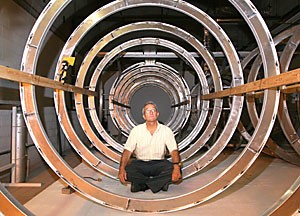The UA’s Controlled Environment Agriculture Center is pioneering a portable life-support system they hope could one day allow humans to survive in space.
“”What the moon-based project is trying to do is grow food crops when people go to the next planet,”” said Gene Giacomelli, the center’s director and an agricultural and biosystems engineering professor. “”That food system will also be able to purify water and regenerate oxygen.””
Giacomelli and his team are using a grant from NASA to do preliminary research on portable life-support systems that could eventually be sent to the moon or Mars, said Lane Patterson, a a UA graduate student and research assistant.
“”If you put (together) the right combination of plants and people, it’s called ‘Bioregenerative Life Support’ and it will keep people alive in a closed system,”” Giacomelli said. “”No one has ever done it yet, but in theory it can work.””
The life-support model is an inflatable structure that can land on the surface of a planet and expand several, tube-like arms full of pouches of nutrient solution, hanging on cables, that will support plant life, Patterson said.
One arm of this structure is being constructed by Giacomelli’s team in a lab at the UA Animal Research Center, Patterson said.
“”As far as the plants are concerned, when you put them inside there they won’t know the difference if they’re on the moon or at the South Pole,”” Giacomelli said. “”They see the light, they get their water and their nutrients and they’re happy.””
The UA also built and operates a food-growth chamber in one of the most remote places on Earth – Antarctica.
The South Pole Food Growth Chamber gives the researchers insight into the logistics necessary for operating in conditions similar to space, said Patterson, who was recently in Antarctica operating the chamber for over a year.
“”We’ve got an isolated crew, we’ve got a remote and dangerous location, we’ve got intermittent communication, and we’ve got a small sealed system,”” Patterson said. “”These are all characteristics that a biological life support system would also have.””
The vegetables grown in the South Pole chamber have a dual purpose: testing the limits of controlled-environment agriculture, and providing fresh food for the scientific community at the National Science Foundation’s South Pole Station, he said.
Patterson is now back at the UA and helps run the South Pole help desk, which receives and analyzes data in real-time from 11,000 miles away, he said.
“”The growth chamber is totally automated,”” Patterson said. “”The chamber is really the farmer.””
The Agriculture Center has some more down-to-earth goals, too.
Patricia Rorabaugh, a plant sciences lecturer, teaches her hydroponics class in one of the center’s greenhouses. She said hers is one of several classes that use the greenhouse to care for the plants and for hands-on classroom experiments.
The center is also doing variety testing on tomatoes for Eurofresh Farms in Willcox, where they are testing varieties from different seed companies to search for the ideal tomato, Rorabaugh said.
“”It allows our students to work on tomatoes and learn how to grow these plants,”” she said of the center and the classes offered within it.
The educational greenhouse is one of several operated by the CEAC and has about 756 plants on a drip irrigation system, growing in bags of nutrients, Rorabaugh said.
“”Winter, summer, spring, fall – it doesn’t matter, you can grow yearround,”” Rorabaugh said. “”That’s the benefit of the greenhouses to the Southwest.””
Emily Rockey, a plant sciences junior, is taking Rorabaugh’s hydroponics class.
“”We control everything: the temperature, the humidity, the light, the CO2, the oxygen, the water, the nutrients – everything,”” she said. “”It’s my favorite class – it’s so relaxing to be in here.””
One of the center’s goals is to continue to develop all aspects of its controlled-environment programs.
“”We do greenhouses for Earth, to feed people, and then we do systems for other planets.”” Giacomelli said. “”You give us water and you give us solar energy and in these systems we can grow plants to feed people and keep them alive.””









